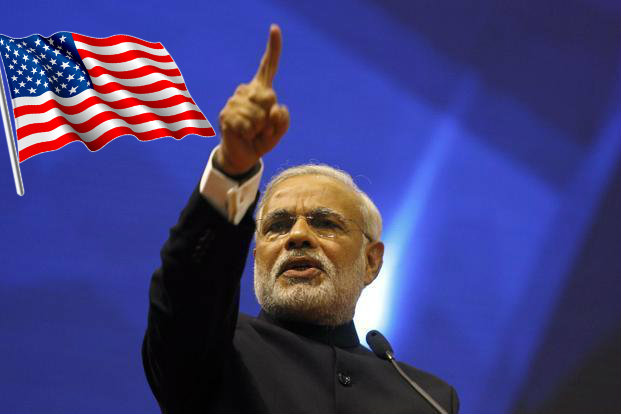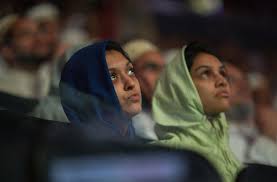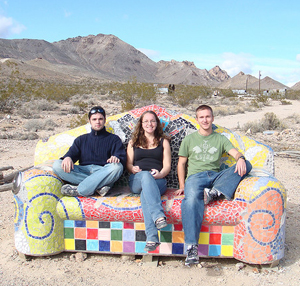The Indian Moment

by Harvey D. Shapiro
 “Modi! Modi! Modi!” the audience chanted. Some 20,000 Indian-Americans had filled Madison Square Garden, New York’s storied indoor sports arena a few weeks ago to hear Indian Prime Minister Narendra Modi, who had come to the U.S. to address the United Nations and meet with U.S. President Barack Obama. Modi, who spoke in Hindi from a revolving platform, was escorted into the arena by Nina Davulur who had just become the first Indian-American Miss America.
“Modi! Modi! Modi!” the audience chanted. Some 20,000 Indian-Americans had filled Madison Square Garden, New York’s storied indoor sports arena a few weeks ago to hear Indian Prime Minister Narendra Modi, who had come to the U.S. to address the United Nations and meet with U.S. President Barack Obama. Modi, who spoke in Hindi from a revolving platform, was escorted into the arena by Nina Davulur who had just become the first Indian-American Miss America.
His appearance was preceded by a recording of the Bruce Springsteen classic, “Born in the U.SA.” but few in this audience were, in fact, born in the U.S.A. And many of them were celebrating their own triumph as well as Modi’s. Indian-Americans are on a roll. Barely visible in the U.S. two decades ago, their numbers have risen from 1.6 million in the 2000 census to 2.8 million in 2010, a 70 percent increase that makes Indians one of the fastest growing ethnic groups in the U.S. They’re still a small part of the American mosaic, but as their numbers have grown so has their prominence, and their prosperity. A recent survey found that Indians had surpassed Reform Jews to become the highest earning ethnic group in the country. The median annual income for Indian households in 2013 was $88,000, vs barely $50,000 for the average U.S. household. Half of Silicon Valley seems to be composed of Indians (and the other half is Chinese), and Wall Street is increasingly replete with Indians as well.
Despite the prominence of a few Indian-Americans in Silicon Valley, nearly a quarter of all Indian-Americans live in the greater New York area, and the city itself is home to some 210,000 of them, by far the largest concentration of Indians in the U.S. Indians now dominate two adjacent districts in the borough of Queens — Jackson Heights and Flushing. There the landscape is dotted with Indian grocery stores and restaurants, beauty salons and sari shops, Hindu temples and travel agents specializing in India trips. There are dozens of Indian doctor’s offices, as well as offices of immigration lawyers, and stores specializing in shipping parcels to India. And there are astrologers, shops selling Indian videos, and stores selling the gold jewelry traditionally favored by many Indians as both a decoration and an investment. There are probably two dozen Indian restaurants clustered near the intersection of 74th Street and 37th Avenue in Jackson Heights.

One survey found that 69 percent of Indian Americans age 25 and over have a four year college degree, compared to 30 percent for whites. Indians start with an advantage over other immigrants groups– Most speak English when they get here. And, like the Chinese, they are renowned for their diligence in education. Indians students have carved out a unique reputation in spelling contests. In May, two Indian American teenagers were declared co-champions of the Scripps National Spelling Bee. The past eight winners and 13 of the past 17 have been of Indian descent, a run that dates back to1999.
Indians have flooded into several professions. Seemingly half the doctors in New York are Indians. (And the other half are Russian.) Nina Davulur, the current Miss America, is the daughter of a doctor who emigrated from India 30 years ago, and she plans to become a doctor. Indians are also ubiquitous in high tech fields. Open the door to the IT department at any sizable New York business, and the room will be full of Indians. Nationally, although Indians are barely one percent of the U.S. population, they comprise about eight percent of the nation’s doctors, seven percent of the IT workers, and three percent of the engineers. About a quarter of Indian American men born in India work in IT.
Indians are also involved in running newsstands in New York and owning motels across the country. What Indians are not doing is running Indian restaurants – many of the places offering Indian food in New York are, in fact, operated by immigrants from Bangladesh; they don’t have the educational credentials to enter the professions. (Immigrants from troubled and impoverished Bangladesh are likely to soon outnumber Indians in New York.)
 In contrast to other immigrant groups, Indians do not begin their American journey in poor neighborhoods in Manhattan. Earlier immigrants created Chinatown, Little Italy, Spanish Harlem, and the once heavily Eastern European Lower East Side in Manhattan. But Indians started out in Queens, and have built an enormous community there as well as just across the city border in Hicksville, Long Island, and in several northern New Jersey suburbs.
In contrast to other immigrant groups, Indians do not begin their American journey in poor neighborhoods in Manhattan. Earlier immigrants created Chinatown, Little Italy, Spanish Harlem, and the once heavily Eastern European Lower East Side in Manhattan. But Indians started out in Queens, and have built an enormous community there as well as just across the city border in Hicksville, Long Island, and in several northern New Jersey suburbs.To be sure, there’s a little India in Manhattan — two blocks filled with Indian restaurants and spice shops. But there’s also a Little India in Jersey City, New Jersey, and demographers tally some 24 Indian-American enclaves around the Metropolitan area.
While the Indian community in Queens is more prosperous than other immigrant neighborhoods, it is struggling with the same kind of identity issues common to all immigrant groups as young American-born Indians confront their parents’ folkways. They’re still very family-oriented, and social life revolves around spending time with parents and relatives. But a major challenge has been the process of finding a mate.
Traditionally, Indian mothers do the matchmaking, identifying and investigating prospect spouses for their offspring. Young American Indians are determined to meet up on their own — but they often do so through Indian student associations and other Indian organizations. And if a girl announces she likes a certain Indian boy – and he better be Indian — her mother is likely to swing into action, tapping into her network in the U.S. and in India to check out the boy’s family. If all goes well, the process culminates in a lavish, days-long wedding at a fancy hotel, with the families trying to outdo each other in the lavishness of the saris and the amount of gold jewelry. All the major hotels in the metropolitan area have mastered the cuisine and décor for Indian celebrations.
Indian cultural events are increasingly visible in New York. Popular entertainers from India turn up regularly, and Bollywood movies are shown in several theaters. At Curry in a Hurry, a cafeteria serving Indian food and frequented by Indian taxi drivers on their breaks, they even show Bollywood videos in the dining room.
Because Indians do well in school and have prospered mightily, many consider them to be the Model Minority. To be sure, they face some discrimination, and taunting. Sikhs are forever having to defend their right to wear their turbans if they want to join the army or the police force or get involved in food preparation. But Indians’ only vocal adversaries seem to be a tiny cadre of Know Nothings who mistakenly think Indians are all Muslims and therefore terrorists.
In contrast to other ethnic groups who have often fled their native country and easily turn their back on their homeland and culture, many Indians remain vitally interested in Mother India. It’s an annual ritual to take the children to see relatives back in India. And to follow things like the election of Modi. He is said to be seeking to capitalize on those feelings by cultivating the Indians diaspora in New York to generate more of the investment capital and skills needed to spur India’s economic development: That may explain his appearance at Madison Square Garden.

In some ways Indians seem more caught up in the politics of India than America. While Indians are front and center in high tech and Wall Street, they aren’t very visible yet in New York politics. But they are big supporters of the Indian politicians who have emerged elsewhere. Bobby Jindal, governor of Louisiana has expressed interest in running for President. Jindal, a conservative Republican, is in many ways the perfect ethnic candidate: Indian, yes, but instead of using his given name, Piyush, he goes by Bobby, an all-American first name, and he’s a Christian, not a Hindu — which would be a faith too exotic for many American voters. There’s also Nikki Haley, the Republican governor of South Carolina, and a small number of other increasingly visible Indians in state and local government positions. One day soon, one of them will run for President, and when they do, there are large numbers of Indians who would fill Madison Square Garden to listen to him or her, and, perhaps more importantly, would be willing and able to write the large checks needed to finance a Presidential campaign.













Social